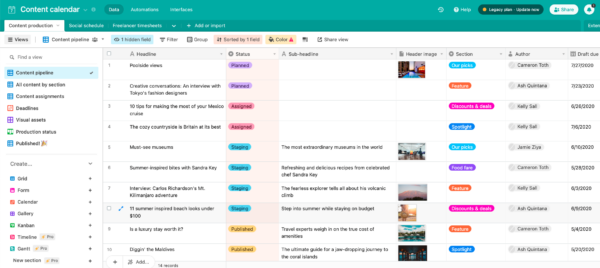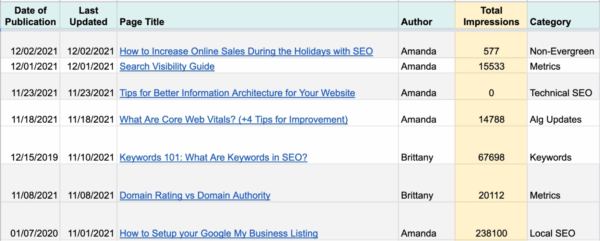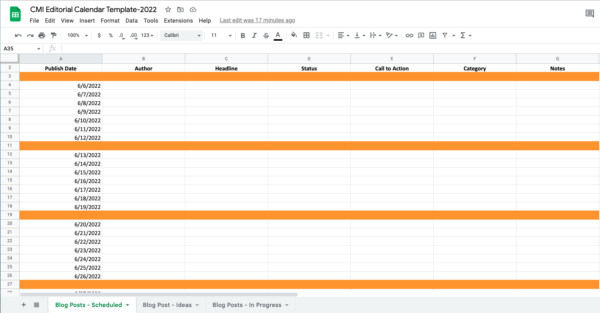Quick: Name the tool most critical for effectively managing your content marketing program.
No matter your role or responsibilities, the answer should be an editorial calendar.
Why? Content creation involves a million small tasks. A reliable system keeps track of all those processes and each content piece’s status as it moves through them.
But content marketing editorial calendars can do much more than that.
They can streamline strategic collaboration, track marketing performance, and identify content repurposing opportunities.
With a thoughtful approach and proper configuration, editorial calendars can enhance team productivity and add clarity at every stage of your brand’s content marketing journey.
Learn how to build a customized content marketing editorial calendar – and how to maximize its benefits – with these tips, examples, and templates.
1. Set the foundation for an effective editorial calendar
Gather key information from your content marketing strategy to inform your content creation plan. Answer the following questions to help determine what to track in your calendar and stay focused on your marketing goals.
Who are you creating content for?
You can’t create the right content if you don’t have a clear understanding of the target audience. Use the insights in your content personas to focus on their informational needs and topical interests.
What will your content help your business achieve?
Are you looking to generate leads? Increase your thought leadership? Drive attendance to your events? Your content marketing mission and goals will impact what you publish, where you publish, how often, and how your team prioritizes, organizes, and categorizes/tags its content creation efforts.
What creative resources do you have?
Will you work with an in-house team of writers, designers, and videographers? A stable of industry pros sharing their insights? A mix of internal and external contributors? The tracked formats, frequency, and workflow stages likely depend on with whom you’re collaborating and the nature of their expertise.
TIP: Need to enhance your creative capabilities to handle the workload? Follow this complete guide to outsourcing content creators.
What will make your content distinct?
How can your brand deliver content with a unique mission? What unmet industry needs can the content address? What gaps exist in your or your competitors’ content? Can you tie your content to industry events for added exposure? Knowing how to attract a larger share of your audience’s attention lets you fill the content marketing editorial calendar with impactful ideas and assets.
What are the steps for producing quality content for your brand? What tasks and team members factor into your content workflow? Who manages each aspect, who else helps, and who needs to approve the pieces? Those insights determine what information to include in your calendar and how to structure it for optimal use.
2. Build your content marketing editorial calendar
Multiple calendar-building options exist, from simple spreadsheets to project management software. You can also use calendar tools integrated into content workflow management platforms and access free templates online.
Picking your calendar tool
Knowing some of the pros and cons of each option will help determine the best choice to build your marketing editorial calendar.
Project/task management software
Tools like Trello, Airtable, Basecamp, or Asana are great for organizing tasks, collaboration stages, and asset status. They include tagging, annotation capabilities, and drag-and-drop functionality that make them ideal for tracking content from ideation to execution.
For example, Clare McDermott recommends Airtable for content planning because it combines elements of spreadsheets and databases.
@Airtable is amazingly useful for editorial calendar planning because it’s an elegant combination of spreadsheet and database, says @clare_mcd via @joderama @CMIContent. Click To TweetAs shown in her editorial calendar template example, one calendar tracks multiple elements – the headline, author, deadline, topic/category, and production status.
You can use filters to zoom in on specific details about the content pipeline, such as articles by a particular author or assets that include visuals.

However, some project management tools build templates with developer or marketing needs in mind. You need to adapt them to work well in an editorial environment – which could become more of a time-suck than a time-saver.
Editorial workflow management platforms
Dedicated content management and editorial workflow software can offer editorial calendaring features better suited to the needs of content marketers. They are also more likely to integrate well with other enterprise content technologies, like your CMS (e.g., WordPress), email marketing systems, or asset management tools.
All-in-one systems can be complex and pricey, so they may not be the best option for small teams or smaller-scale content marketing programs.
Fortunately, some offer free editorial calendar templates without purchasing a software license. They may include advanced features that would be hard to build on your own.
For example, ContentCal asks a few questions, such as your types of content, publishing frequency, and target platforms. With that information, it creates an annual calendar with target publishing dates for each type of asset.
Spreadsheets
You can always start with a simple Excel spreadsheet or a shareable Google Sheet. It’s easy to configure them to track fundamental tasks like production steps and publishing dates for a blog or social media posts. Just label the columns and rows for all the information you need.
For example, the CMI editorial team bases its editorial calendar on a template like this one for the blog. It details the production information for each day’s article – headline, author, topic category, and workflow status. (Download your own copy and adjust it as needed).
Uploading your spreadsheet to a cloud-sharing system (like SharePoint, Box, Dropbox, or Google Drive) makes it easy for your team to access and update the information as each asset moves through the process.
Spreadsheets lack advanced features that make complex workflows easier to manage (like content that involves sales or requires developer skills). They also can quickly get unwieldy when tracking multiple processes like creation and performance tracking or multi-channel content experiences.
Also, spreadsheets don’t always integrate well with other enterprise systems and processes, so consider your collaboration needs before choosing this option.
Start with essential workflow details
How you fill out your editorial calendar ultimately depends on your goals, resources, and content plan. At the most fundamental level, it should include these fields for each content asset:
- Date of publication
- Topic or headline
- Author
- Required features – cover image, video or audio asset, ad obligations, etc.
- Owner – who manages the workflow for that asset and/or approves the final piece
- Status – update as the content moves through the publishing cycle
Add useful extras
Depending on the content and workflow, you may want to track the following elements to ensure your content follows the strategy over the long term.
Distribution channels
When working with multiple channels, tracking the where and when of distribution is critical.
You can use this starter template as a model. It tracks basic publication details for each channel, such as the targeted personas, publishing frequency, and topics. This example also includes fields to identify relevant calls to action and target KPIs.

TIP: Learn to build a channel plan to put your content in the hands of the right consumers at the right time.
Content formats and types
Are you focused on a single type or multiple types of content (e.g., blog posts, podcasts, videos)? What format(s) will be used for those types (e.g., live streaming interviews, scripted presentations, product demos)? Tracking this information is helpful, especially when repackaging your assets into other formats or for use on additional platforms.
Visual elements
Don’t overlook the appeal of visual content in terms of social-sharing potential and brand recognition. Tracking the visuals – such as cover images, logos, illustrations, or infographics – ensures your content has a consistent look and cohesive brand identity.
Topics/categories
Including topics and categories makes your calendars more searchable and can help uncover opportunities to fill coverage gaps.
Keywords and other SEO metadata
This information includes meta descriptions and SEO titles (if different from the headlines). Including these details in the editorial calendar visually reminds you to optimize the content for targeted keywords and align with the business’ SEO strategy.
Calls to action
Tracking CTAs on your editorial calendar ensures every content piece is focused on achieving a goal for your business.
URLs
Tracking the URLs of each published piece can help content inventories and audits and make it easier to build backlinks to your highest-converting content assets.
Repurposing details
You can add fields to indicate the content’s last update date and its performance against a target KPI. Indexing this information turns your content marketing editorial calendar into a mini content audit to identify high-performing content to recycle and republish.
Sample
Manick Bhan offers a sample template for this small-scale content audit. In addition to tracking the content’s original and updated publication dates, it includes the page title, author, total impressions, and topical category.

3. Keep your editorial calendar filled and focused
A consistent publishing schedule requires a steady flow of engaging topics and ideas to turn into valuable content.
Incorporate a running list of story ideas into your editorial calendar. The list can also be an easy reference when looking for gaps in your coverage or provide extra inspiration for your team’s creative brainstorms.
Ben Taylor, founder of HomeWorkingClub.com, suggests using a card-based project management system like Trello. “Create a column for ideas, then anybody on the team with access can submit them,” he says. For ideas you plan to take forward, just drag their cards into your workflow.
@homeworkingclub likes @trello for #brainstorming because it lets ideas move easily through your #content workflow via @joderama @CMIContent. Click To TweetAgain, the fields to track content ideation can vary. At a minimum, track the following:
- Topic idea
- Owner of the idea
- Target keywords/categories to which the content would map
- Who might be available/qualified to author the piece
- Marketing goal the idea aligns with
- Projected publishing timeframe
4. Evaluate more ways to use editorial calendars
Editorial calendars can be helpful for a range of content marketing tasks beyond tracking your creative process and managing your publishing workflow.
Diversity and accessibility compliance
To ensure your content complies with accessibility standards and features diverse perspectives, include those details in your tracking system. For example, the CMI editorial team’s calendar includes a field to note that the content has been reviewed for inclusivity considerations and/or highlights the expertise of writers from diverse backgrounds.
External collaborations
If you work with external content contributors and influencers, add the relevant details of those engagements to the content marketing editorial calendar.
Whether you use dedicated influencer management tools or just add a separate tab in your main editorial calendar spreadsheet, these details can simplify the assignment process and ensure on-time assets:
- Writer’s name
- Contact details
- Preferred topics
- Standard turnaround times
- Channels and platforms they work with
Reporting
Keeping a record of the content as it is created gives you a head start in tracking the performance of each piece and regularly sharing the results with your team and upper management.
You can add columns (or tabs) to your main calendar to keep on hand the most relevant analytics like page views, clicks, or conversions. Alternatively, you can grab the most pertinent information about the content from the calendar and plug it into a separate reporting template.
Aligning content across the enterprise
Sharing your content calendar with sales, marketing, HR, public relations, and other departments helps them understand and better leverage your content efforts to further their own goals. That connection may make them more likely to alert you when they’re involved in new events or opportunities that might spark fresh ideas or impact your project priorities.
Ease your process pain with the right editorial calendar
The possibilities are practically endless when it comes to using editorial calendars to organize your content marketing and keep your efforts moving in the right direction. What additional tips, tools, and ideas have worked well for your calendaring efforts? If you have other suggestions, please share them with your fellow content marketers in the comments.
All tools mentioned in the article are identified by the author. If you have a tool to suggest, please add it in the comments.
Cover image by Joseph Kalinowski/Content Marketing Institute
Updated from an April 2017 post.



